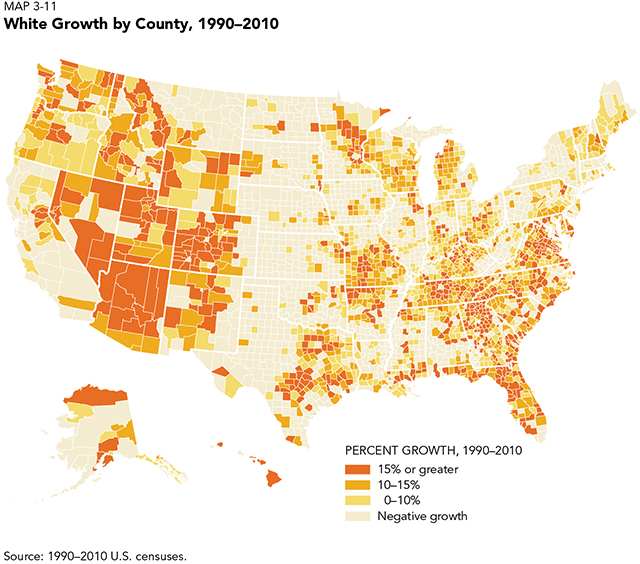The white population is barely growing and, in about 10 years, will begin to decline—a consequence of an old age structure, fewer births, more deaths, and little immigration. What that means is that many places, especially those experiencing out-migration, are already experiencing white population losses. During the first decade of this century, white population losses were registered for 15 states, nearly half of our 360 metropolitan areas, and over half of our 3,100 counties.
Where are the losses occurring? A look at white growth and decline over the 1990-2010 period provides a perspective (see map, from my book “Diversity Explosion”). Some areas that are seeing declines in their white population caused by migration—particularly many counties in the Great Plains, the Midwest, and parts of the South—are also experiencing an excess of deaths over births in their white populations.

States losing white population fall into two categories: those in which employment slowdowns have triggered major out-migration (e.g., Michigan, Ohio), and urbanized coastal states with high costs of living (e.g., California, New York, New Jersey). In fact, metropolitan New York and Los Angeles lost over 1 million whites each between 1990 and 2010.
The areas that are gaining whites overlap heavily with those that are attracting dispersing minorities— prosperous and affordable parts of the Southeast, Southwest, and Mountain West—including suburbs, exurbs, and smaller metropolitan areas. But it’s pretty clear that, going forward, the nation’s white population shifts will be a “zero-sum” game: As some areas experience greater white population gains, others will suffer losses.
Material adapted from Diversity Explosion: How New Racial Demographics Are Remaking America by William H. Frey, 2014.
The Brookings Institution is committed to quality, independence, and impact.
We are supported by a diverse array of funders. In line with our values and policies, each Brookings publication represents the sole views of its author(s).




Commentary
The geography of white population loss
April 30, 2015